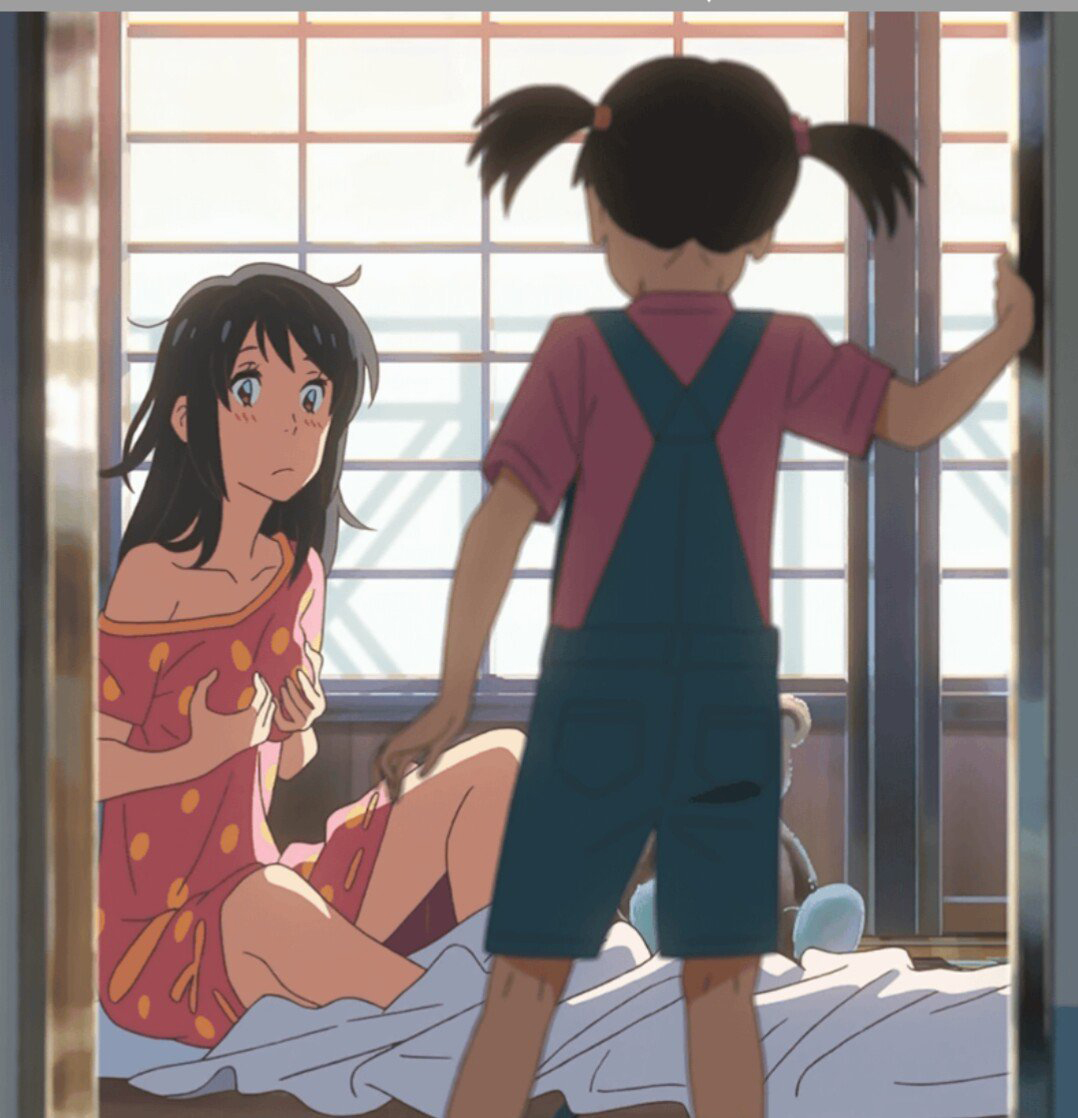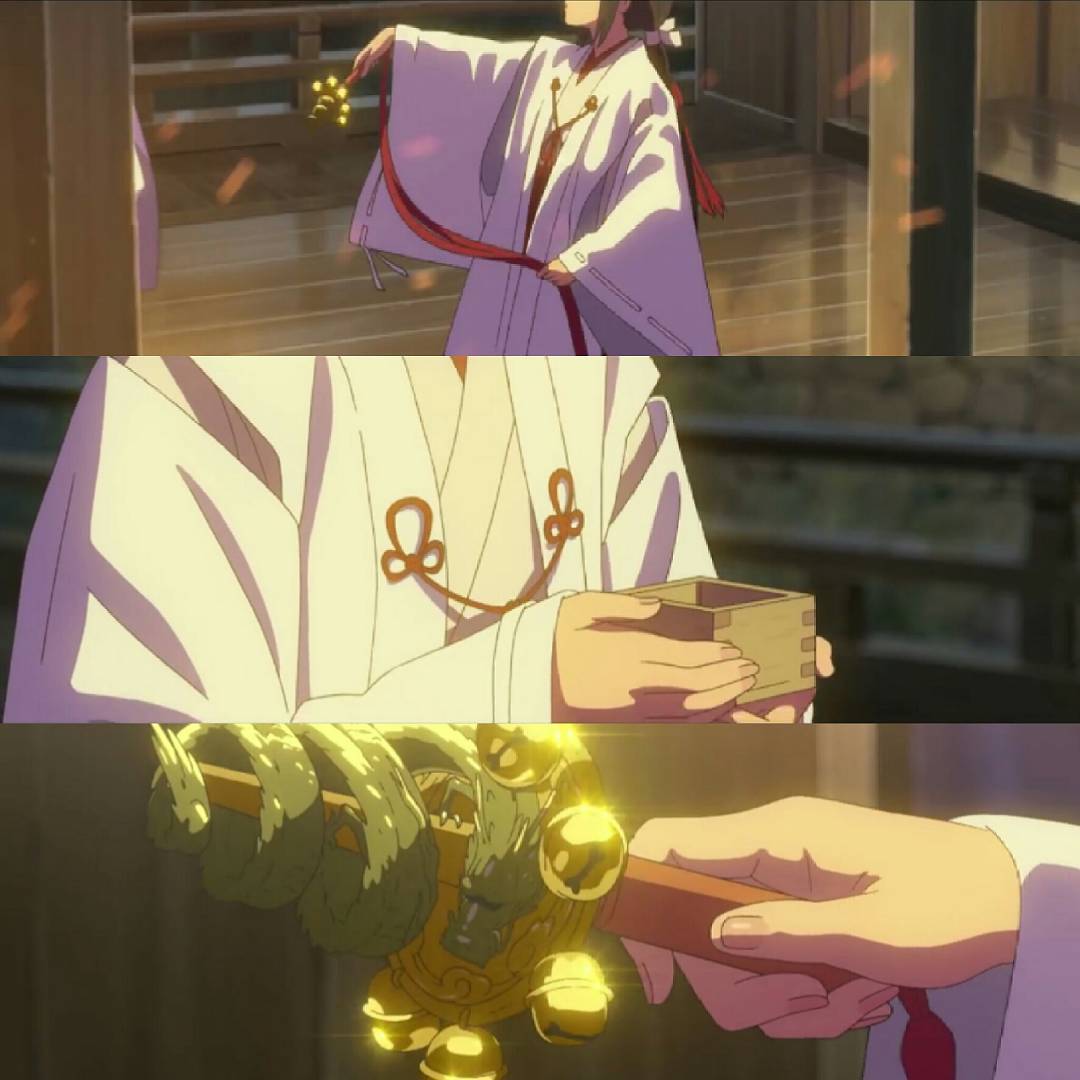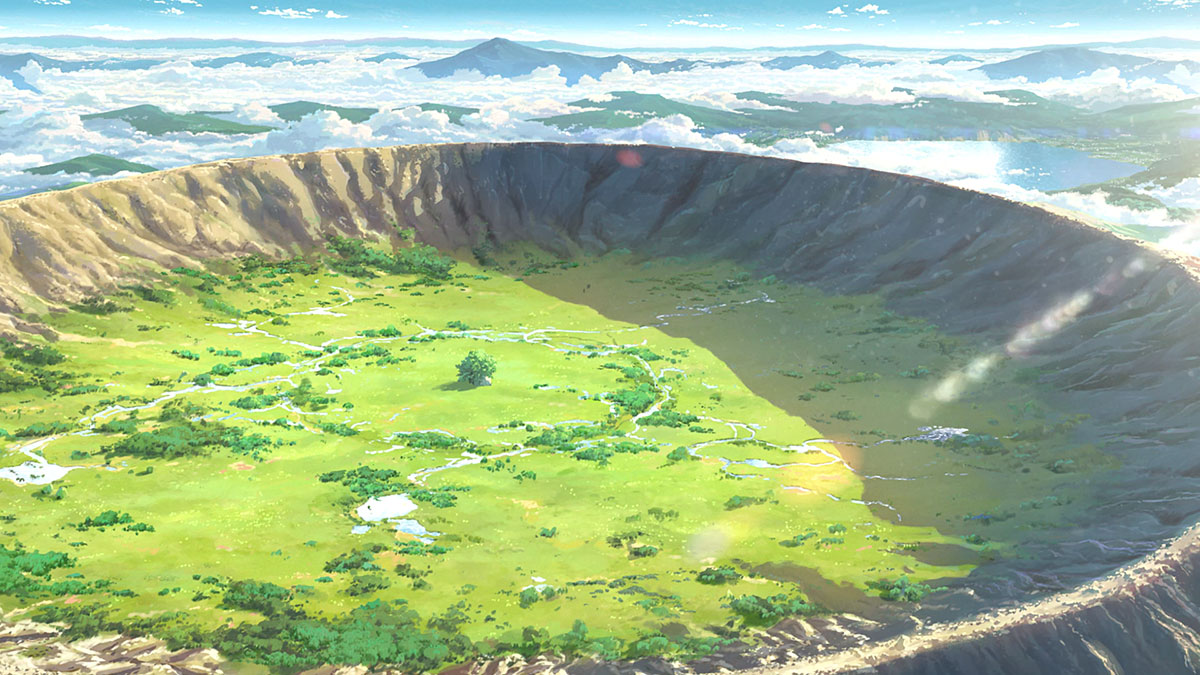Japan Modern Culture: Kimi no Na wa – Your Name
Kimi no Na wa – Your Name

Photo credits: Tumblr.com
Your name (original title: 君の名は。- Kimi no Na wa.) is the popular Japanese animated film directed by Makoto Shinkai and produced by CoMix Wave Films. Between 2016, year of the release, and 2017 it has become a big box-office hit not only in Japan but all over the world.
The work has the traits of a teenage love story, but also that of a sci-fi thriller with references to Japanese traditions and culture. With continuous changes of perspective and time, a vivid and enveloping animation, a soundtrack that accompanies scenes and underlines every detail, Your name has won millions of fans over.
The Plot

Photo credits: www.zerochan.net
Focus of the story are two high school kids, Mitsuha Miyamizu and Taki Tachibana.
Mitsuha lives in the small mountain village of Itomori, near Tokyo, and loves spending her time with her two friends Sayaka and Tessie. She has a younger sister and a father, a local politician, who seems to care little for them. Their mother died and the two sisters live with their grandmother. Mitsuha, like her grandmother, is destined to become a Miko, a priestess of the local temple of which her family is the guardian. But this kind of life doesn’t suit her, as well as causing her a bit of embarrassment with her schoolmates. What she really wants is to move to the glittering metropolis and live like a normal girl, or better, be reborn as handsome boy from Tokyo.
Taki, on the other hand, lives right in the center of Tokyo and leads a normal life with his school duties, friends and his part-time job. In his free time he works as a waiter in an Italian restaurant, Il giardino delle parole (The garden of words), a name that is a clear reference to Shinkai’s previous work. He is a bit impulsive but still kind at heart, and hopes to become an architect in the future. Like the other male coworkers, he is in love with his beautiful colleague Miki Okudera.
One day, however, the life of the two protagonists, who live without knowing of each other’s existence, is overturned by something unbelievable. In what seemed like a normal morning, the two find out they have switched their bodies without any plausible explanation. These exchanges will continue for some time so that, after the initial surprise, the two try to adapt to their new condition. Communicating mainly through a diary on their cell phones they will in a way help each other. Mitsuha, with her sweet and affable side, will help Taki to have a date with the colleague he is in love with. Taki, with his temperament, will help Mitsuha face his classmates and become more self-confident. It will not take long before they begin to feel something for each other, even though they have actually never met.

Photo credits: twitter.com
One day Mitsuha tells Taki about a comet that will pass by on the day of his date with the beautiful Okudera. At Itomori, that will be the day of the autumn festival. The boy does not understand what she’s talking about but, when he tries to call Mitsuha on the phone for the first time, his attempt fails. He understands that for them it is no longer possible to switch bodies and so he decides to go and meet her in person. When he finally discovers the name of her village, he also finds out that it had been destroyed three years before. A fragment of the comet Tiamat had fallen on Itomori destroying the village almost completely and killing a third of the inhabitants, Mitsuha as well.
Taki then goes to the sanctuary of the local guardian god, Musubi, on top of Mount Hida just outside the village. After entering the holy place he decides to drink the Kuchikamizake, the sake prepared by Mitsuha and that he himself, with her body, had left there as an offer. This allows him to actually travel back in time. He sees Mitsuha’s past and wakes up in the girl’s body again, just before the comet’s fall. Aware of what will soon happen Taki does everything to ensure that the inhabitants of the village recognise the danger themselves. But he also knows that this is his last chance to see Mitsuha. He runs to meet the girl at the top of Mount Hida, where his body of the future had been left. Here, the two protagonists can see each other, for a few moments, before their memories are erased. Their commitment saves the village thus changing the course of history, but at the same time leaves a sense of emptiness inside of theme. A hole left from something to which they can not give either a name or a face that urges them to look for each other, even if they have no recollection of what had happened.
The Success

Photo credits: one–anime.blogspot.it
The film, which premiered in July 2016 at the Anime Expo in Los Angeles, was then released in Japanese cinemas starting from August that year. Immediately acclaimed as a masterpiece, in its triumphal march it reached 92 countries, earning more than 355 million dollars. This makes it the 1st-highest-grossing-anime in history. A goal that even authors themselves did not expect to reach.
This commercial success made it the 2nd-highest-grossing film of all time in Japan after Hayao Miyazaki’s Spirited Away. It also is 4th-highest-grossing film after Titanic and Frozen. But it has also earned the position of most watched Japanese anime in several other countries of the world.
As for Italy, the first Italian trailer was released only on December 6, 2016. Subsequently, the film was screened in about 160 theaters from 23 to 25, January 2017 thanks to a collaboration between Dynit and Nexo Digital. The success at the box-office was so great that several other dates were decided, with a total income of around 700,000 euros.
Looking at these numbers, it’s no surprise that director Shinkai has been sometimes referred to as Hayao Miyazaki’s successor. Title that the person himself has humbly refused saying he does not deserve it.
Themes and Symbolism

Photo credits: instarix.com
The inspiration for the story came to the author from works such as Inside Mari by Shūzō Oshimi or Ranma ½, as well as from classical works such as the Torikaebaya Monogatari dating back to the Heian period (794-1185). But another source of inspiration for the author seems to have been an ancient poem by the poet Ono no Komachi, who lived between 800 and 900. In one of her poems the woman wrote: “Before I slept I thought of him, and into the dream he strayed. Had I known it was a dream, in the dream I would have stayed.”
And in fact, rather than swapping, the two protagonists of Your Name dream of each other. This is possible because Mitsuha is a priestess devoted to the God Musubi, the deity that governs experiences and human connections. When Taki, in Mitsuha’s body, reveals himself to her grandmother, the old woman does not seem so surprised. Indeed, she herself had experienced the same thing, being it a particular family power, even though she no longer remembered the boy in her dreams.

Photo credits: forum.gamer.com.tw
Located at the top of a mountain that appears to be the crater caused by a previous appearance of the comet, the temple is a sacred place. It represents the boundary between the kingdom of Gods and Earth, between the realm of the living and that of the dead. To return to the mortal world you have to leave a part of yourself, and Mitsuha left a part of herself in the sake she prepared. The creation of the Kuchikamizake is a family tradition, along with traditional dances and braiding threads. It is a particular method of creating sake which involves chewing rice to activate its fermentation.
In this regard, Mitsuha grandmother’s words are very important:
“Musubi is the old way of calling the local guardian kami.
Tying thread is Musubi. Connecting people is Musubi.
These are all the kami’s power.
So the braided cords that we make are the kami’s art and represent the flow of time itself.
They converge and take shape. They twist, tangle, sometimes unravel, break, then connect again.
Musubi-knotting. That’s time.
Musubi is also sharing something with others”
These words not only represent a very profound spiritual concept, but also make us understand the power of Taki’s gesture when he drinks the sake prepared by Mitsuha. In fact, this gesture is a symbolic act of profound connection in which the young man assumes in himself a part of Mitsuha and of her spiritual power, allowing him to meet her as well.

Photo credits: fakemorisummer.wordpress.com
Equally symbolic is the fact that the two of them meet at sunset. In fact, according to ancient legends sunset is the moment when the boundary between the world of the spirits and the world of the humans fades for a short moment. And that’s why they can finally meet, even though Mitsuha had died 3 years before. The two, however, have to sacrifice their memories in order to return to the earthly world.
Another Japanese legend finds its space in the story. Taki and Mitsuha seem to be linked by what many know as the ‘red thread of fate’ that is said to tie two people destined to be together. Red thread that, in this case, is symbolized a thread that Mitsuha herself had made and then gave to Taki.
Shinkai, who as we said before did not expect the worldwide success it had in terms of audience, said that it was his intention to create a film that targeted Japanese youth. He wanted to create something that would push them to believe in their future.
He said: “I created this movie hoping that younger audiences would believe that ‘maybe there is the one in my life I might have not met yet but hopefully will see tomorrow or in the future.’ ”

Photo credits: www.amazon.co.jp
Another important issue addressed by the film is the juxtaposition between the small rural village and the great metropolis of Tokyo, something that the author himself has experienced. In fact, he grew up in a small village and later moved to Tokyo, which is common to many young Japanese people.
Here we see Mitsuha, she lives immersed in local traditions but yearns for the city life; and we see Taki, immersed in city life, that learns to appreciate the past and traditions.
Once again, it is the grandmother’s words that help us: “Even if the words have been lost, it is important to preserve these traditions”. With this, it looks like she want us to remember where we come from, in opposition to her son, a corrupt local politician who chose to abandon the temple completely.
Ancient traditions represent the founding substratum of a community, what the present is based on and which binds people together. And also what enables them to face even the darkest times.
Japan is no stranger to natural disasters, just remember the recent earthquake in 2011, or the great Kanto earthquake in 1923. And how to forget the atomic disaster that put an end to Second World War. In all these occasions Japan has always found the way to start anew, placing one interest over the others: what can we do to prevent this from happening again. No wonder then that in this film the two protagonists try to prevent what would have been a real tragedy.
The goal of the film is to give hope, but also invites us to never forget our roots and the spiritual union that they can create.
We could therefore say that Your name has a cathartic function for the viewer.
Strong Points

Photo credits: Lovejude
Whether you are among those who liked the film or not, Your Name certainly has several objective strong points.
First of all, the animation and the extremely realistic render of setting, as it is in the style of the author after all. The film’s landscapes are described in every detail and the colors are warm and bright. The images are so vivid that are able to convey, even with their colors only, the intense and pure emotions of the protagonists, thus contributing to the cathartic function of the film.
Also worthy of mention is the soundtrack that was composed by the vocalist of the Japanese rock band Radwimps, Yojiro Noda.
Noda, specially requested by Shinkai himself, had only one request to respond to :
“make it in a way that the music will (supplement) the dialogue or monologue of the characters”.
And considering the results we can say that this soundtrack is one of the keys to the success of the film..
This world seems like it still wants to keep me tamed
As you wish, then- I’ll struggle beautifully.
Your Name Theme song – Yojiro Noda
Yet despite the positive critics, Shinkai claimed that the film is actually not as good as he had thought. The lack of time and funds forced him to deliver to the public a work that he himself calls incomplete. He stated : “There are things we could not do, Masashi Ando [Director of animation] wanted to keep working [on] but we had to stop for lack of money … For me it’s incomplete, unbalanced. The plot is fine but the film is not at all perfect. Two years were not enough.”
Related Products and Remake

Photo credits: Amazon.co.jp
In addition to the film, products related to Your Name include other works, such as a novel, manga, film guides and CDs. In December 2016 alone, the sales of these products amounted to around 2.5 million copies.
The novel and manga of the same name are published in Italy by the J-Pop publishing. The Blu-ray and normal DVD versions, released in July 2016, arrived in Italy in November 2017.
Sales confirmed the success in cinemas.
Last September it was also announced that Kimi no na wa will soon have a Hollywood live action adaptation.
The chosen producer is none other than J.J. Abrams (Star Trek, Mission impossible). The announcement has already triggered the reaction of many people, both fans of the film and those who are simply curious. There are many voices worried that this adaptation could overturn what is considered a masterpiece.
And records do not seem to play in favor of this live action. It is still recent news that the director of Death Note’s Netflix remake had to close his Twitter account after being strongly attacked for his work. Attacks that did not spare another adaptation of the popular anime Ghost in the shell, whose film with Scarlett Johansson did not really satisfy its fans.
Kimi no na wa is certainly not a easy film to adapt in a western setting because of its numerous references to particular places and particular cultural and religious concepts. Think of Mitsuha and her family, guardians of the shrine of the deity Musubi and the ancient traditions of the village.
As for the places, in addition to Itomori which is a fantasy village, there are real cities. Not only Tokyo, but also Hida, and the Itomori Lake itself is inspired by a famous Japanese lake, Lake Suwa.
Only time will tell us what the future of this adaptation will be.
Trailer:
Share this:
- Click to share on Facebook (Opens in new window)
- Click to share on Twitter (Opens in new window)
- Click to share on Tumblr (Opens in new window)
- Click to share on Pinterest (Opens in new window)
- Click to share on Telegram (Opens in new window)
- Click to share on WhatsApp (Opens in new window)
- Click to share on Reddit (Opens in new window)
- Click to print (Opens in new window)






